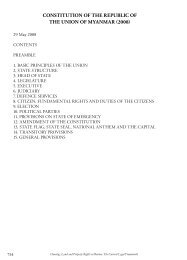Myanmar at the HLP Crossroads: - Displacement Solutions
Myanmar at the HLP Crossroads: - Displacement Solutions
Myanmar at the HLP Crossroads: - Displacement Solutions
You also want an ePaper? Increase the reach of your titles
YUMPU automatically turns print PDFs into web optimized ePapers that Google loves.
35<strong>Myanmar</strong> <strong>at</strong> <strong>the</strong> <strong>HLP</strong> <strong>Crossroads</strong>The St<strong>at</strong>e Law and Order Restor<strong>at</strong>ion Council: 1988-1997On 8 September 1988, <strong>the</strong> military, reorganised as <strong>the</strong> St<strong>at</strong>e Law and Order Council (SLORC) staged ano<strong>the</strong>rcoup d’et<strong>at</strong> and established a martial law regime. The 1974 Constitution was suspended, all institutions of St<strong>at</strong>eth<strong>at</strong> oper<strong>at</strong>ed under <strong>the</strong> Constitution were abolished and SLORC assumed all executive, legisl<strong>at</strong>ive and judicialauthority. Following <strong>the</strong> practice of <strong>the</strong> Revolutionary Council, SLORC similarly asserted th<strong>at</strong> all laws wouldcontinue in force unless specifically repealed. The System of People’s Justice was abolished and a new SupremeCourt was established as <strong>the</strong> highest court in <strong>the</strong> country. In December of 1988, SLORC issued an orderdeclaring th<strong>at</strong> persons with permission to grow paddy had <strong>the</strong> duty to yield harvests to <strong>the</strong> full capacity of <strong>the</strong>field. Only after <strong>the</strong> paddy season was over and <strong>the</strong> set quota sold to <strong>the</strong> Government would o<strong>the</strong>r income earningagricultural products or cash crops be permitted to be grown. In 1989, <strong>the</strong> official name of <strong>the</strong> country waschanged to <strong>Myanmar</strong>, and in 1990, SLORC issued fur<strong>the</strong>r directives to gain total control over land required forfruit orchards, brick production, rice mills, salt production and o<strong>the</strong>r purposes. Farmers were forced to grow paddyas <strong>the</strong> dominant crop; growing o<strong>the</strong>r cash crops, fruits or vegetables was severely restricted, limiting <strong>the</strong> variety offood available for household consumption (and increasing <strong>the</strong> people’s vulnerability to malnutrition).Fur<strong>the</strong>r, a Squ<strong>at</strong>ter Clearance Scheme was adopted by SLORC in <strong>the</strong> l<strong>at</strong>e 1980s with a view to evicting squ<strong>at</strong>tersfrom vacant public land, and Government premises such as factory compounds, railway yards and tracks, priv<strong>at</strong>elands needed for public purposes and areas and compounds design<strong>at</strong>ed for religious purposes. During most ofits period in power, <strong>the</strong> junta pursued an urban beautific<strong>at</strong>ion programme in Rangoon and o<strong>the</strong>r cities which hasinvolved <strong>the</strong> forced reloc<strong>at</strong>ion of hundreds of thousands of urban dwellers to new, distant and very poorly serviceds<strong>at</strong>ellite towns. In one 12-month period (during 1988-1989) 260,000 squ<strong>at</strong>ter residents were forcibly evictedfrom Yangon. A fur<strong>the</strong>r 500,000 people were moved to ten s<strong>at</strong>ellite cities around Yangon in <strong>the</strong> 1990s, all ofwhich lacked adequ<strong>at</strong>e facilities, employment opportunities and basic services. Many of those evicted were formalrights holders over <strong>the</strong>ir homes and lands, with judicial options to resist <strong>the</strong>se evictions effectively absent. Minuteamounts of compens<strong>at</strong>ion were provided to some of <strong>the</strong> evictees, and in many instances those forcibly reloc<strong>at</strong>edwere in fact forced to pay for land plots in <strong>the</strong> far-off resettlement sites.As a fur<strong>the</strong>r indic<strong>at</strong>ion of this <strong>at</strong>titude towards its most vulnerable citizens, SLORC approved <strong>the</strong> Electricity Law(1984). This Act, as amended in 1990 by <strong>the</strong> Electricity (Amendment) Law, provides th<strong>at</strong> whoever commitsenumer<strong>at</strong>ed prohibited acts, including <strong>the</strong> <strong>the</strong>ft of electrical energy, is liable to prosecution and also to paying<strong>the</strong> market value of any destroyed electrical m<strong>at</strong>erials and equipment; clauses which could be used against slumdwellers who, throughout <strong>the</strong> developing world including Burma, often tap into electricity grids in order to accesselectricity when this is ei<strong>the</strong>r not provided by <strong>the</strong> authorities or not o<strong>the</strong>rwise accessible to <strong>the</strong> urban poor.Much of <strong>the</strong> urban redevelopment and forced eviction processes in place since <strong>the</strong> SLORC’s emergence intopower has been based on <strong>the</strong> City of Yangon Development Law (1990) which gives dram<strong>at</strong>ic powers to <strong>the</strong>Yangon City Development Committee (YCDC). Under this law, <strong>the</strong> YCDC is vested with authority to “convertYangon with <strong>the</strong> characteristics of a city of intern<strong>at</strong>ional standards”, including <strong>the</strong> official role of reloc<strong>at</strong>ing squ<strong>at</strong>terson <strong>the</strong> orders of <strong>the</strong> st<strong>at</strong>e. The YCDC has extensive duties and responsibilities, including a number of functionspreviously held by <strong>the</strong> Housing Department: <strong>the</strong> prepar<strong>at</strong>ion of civil projects and establishment of newtowns within <strong>the</strong> limits of <strong>the</strong> City of Yangon Municipality; administr<strong>at</strong>ion of lands within <strong>the</strong> limits of <strong>the</strong> City ofYangon Municipality; determining <strong>the</strong> popul<strong>at</strong>ion which should be allowed to settle properly in <strong>the</strong> City of Yangon;construction, repairing and demolition of buildings; demolition and re-settlement of squ<strong>at</strong>ter huts, squ<strong>at</strong>terbuildings and squ<strong>at</strong>ter wards; construction of roads, bridges and maintenance <strong>the</strong>reof; stipul<strong>at</strong>ion of conditionsfor traffic and parking of vehicles and slow-moving vehicles; construction of gardens, parks, playgroundsand recre<strong>at</strong>ion centres and maintenance <strong>the</strong>reof; carrying out works for lighting of roads; carrying out works forw<strong>at</strong>er supply; construction of reservoirs and pipelines and maintenance <strong>the</strong>reof; carrying out works for sanit<strong>at</strong>ion;carrying out works for public health; construction, maintenance and administr<strong>at</strong>ion of markets; stipul<strong>at</strong>ion ofconditions in respect of roadside stalls; and carrying out precautionary measures against fire.Changes in land laws were made in 1991 with <strong>the</strong> establishment of <strong>the</strong> Central Committee for <strong>the</strong> Management ofCultiv<strong>at</strong>able Land, Fallow Land and Waste Land. The Committee was empowered to scrutinize and grant all applic<strong>at</strong>ionsfor commercially using culturable land, fallow land and waste land for agriculture, livestock breeding, aquacultureenterprises or o<strong>the</strong>r economic development enterprises. It was also granted <strong>the</strong> power to alloc<strong>at</strong>e control over much













